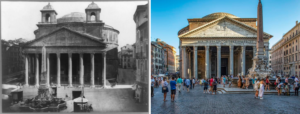Rome is a living museum. Take a walk nearly anywhere in the city, and you will be surrounded by statues, temples, and other monuments representing the glory and grandeur of Roman history. Here is how some of Rome’s most iconic monuments and locations have changed over time. Here’s a look at how Rome’s iconic structures have changed through the ages.
The Pantheon
Originally dedicated to the plethora of Roman gods in ancient times, the Pantheon underwent several renovations before it assumed its ultimate image. Taken in 1870, the left photograph documents the bell towers which once topped the front of the temple. In 1625, Pope Urban VIII commissioned Gian Lorenzo Bernini to construct these structures. Nicknamed the “donkey ears,” in 1870 they were demolished once the papacy lost its regal authority and a new area of semi-secularization began in the city.
Trajan’s Column
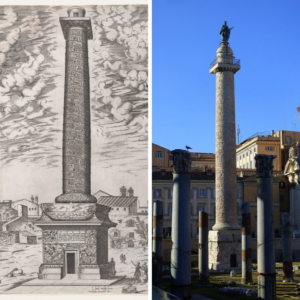
The left illustration (1581-1586, unknown artist) depict’s Trajan’s column without the statue of its namesake emperor. This statue once sat atop the monument since its construction in the second century CE and, during the middle ages, was either lost or stolen. The column then survived without a statue until the reign of Pope Sixtus V, who, under his vision to construct a “New Jerusalem” above the ashes of ancient Rome, commissioned a statue of Saint Peter to be placed on the monument in the late sixteenth-century. The right image shows the statue of Saint Peter still standing today.
The Colosseum (Exterior)
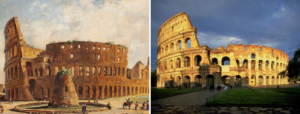
The left painting (circa 1840, unknown artist) depicts a nineteenth-century image of the Colosseum before its excavation. Compared to the present day image, the pre-excavation Colosseum appears to be overgrown with shrubbery and generally neglected. According to this painting and others like it, the Colosseum was also neighbored by a fountain and perhaps comprised a more complete structure itself than it does today.
The Colosseum (Interior)
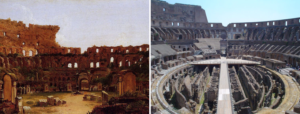
The left painting, an 1832 work by artist Thomas Cole, serves a great representation of what the inside of the Colosseum looked like before its excavation. Notice in the painting the high level of the ground compared to the right photograph; flooding and sediment deposits over the centuries raised this ground level. Also notice in the painting the many religious monuments on the ground in a circular pattern. In the middle ages, Christians transformed the Colosseum into an outdoor church. Today, the interior of the Colosseum exposes the underground of what was one the floor, allowing visitors to see the channels and trap doors that the Colosseum used in the operations of its entertainment.
The Forum
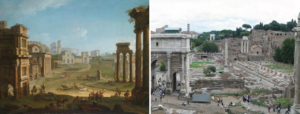
Like the ground level of the Colosseum, the Forum also once had a much higher ground level due to continuous sedimentation throughout the ages. Notice especially the difference in the height of the arch of Septimius Severus (left side of painting and photograph). The left painting, completed in the mid-1700s by artist Antonio Joli, depicts what the Forum looked like after neglect and plundering during the middle ages and beyond rendered the Forums a market for cattle. In fact, for centuries, Romans knew the Forum simply as the “Campo Vaccino,” Latin for “Cow Field.”
Arch of Titus
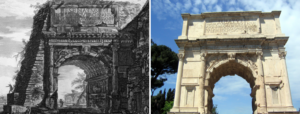
The portrait on the left, a 1748 illustration by artist Giovanni Battista Piranesi, depicts the Arch of Titus before its restoration in the early nineteenth-century. During the five year period in which Napoleon ruled Rome (1809-1814), the Frenchman made it his goal to restore the Campo Vaccino, including one of its main sites, the arch depicted above. As you can see from the left illustration compared to the right photograph, the arch had to be isolated and unearthed as it was previously constructed as a gate to the Forum around the time of the middle ages.
Mausoleum of Augustus
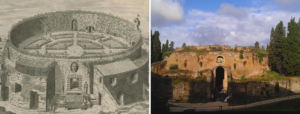
In 28 BC, emperor Augustus commissioned the construction of a mausoleum for himself and his family. The mausoleum today is located on the Piazza Augusto Imperatore, situated near the bank of the Tiber River. The left illustration by Etienne Dupérac in 1600 shows a more complete, circular structure compared the façade of the edifice left behind today.w
Palazzo della Civilità Italiana
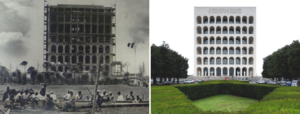
Nicknamed the “Colosseo Quadrato” or “Square Colosseum” by locals, the Palazzo della Civilità Italiana was originally constructed under the rule of Benito Mussolini to serve as a manifestation of fascism for the 1942 World Exhibition. The left photograph served as the cover of Italian magazine Oggi in 1940, showing the building during its construction process.
***
These monuments and locations are only a small fraction of the many wonders and iconic sites Rome has to offer, all with their own stories and unique histories!


